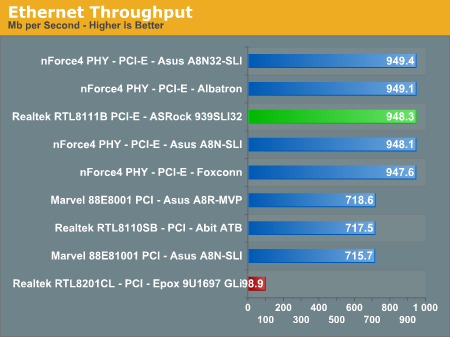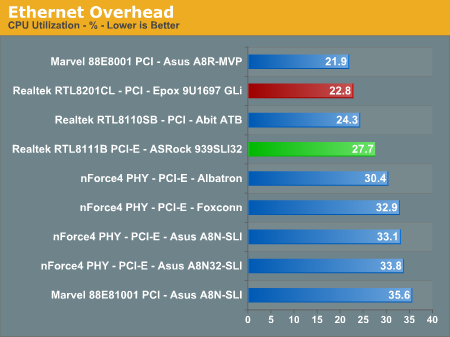EPoX EP-9U1697-GLi: ULi M1697 Goes Mainstream
by Gary Key on March 15, 2006 12:05 AM EST- Posted in
- Motherboards
Ethernet Performance
The current motherboard test suite includes LAN performance measurements. All of these boards utilize PCI Express controllers with the only difference being the supplier of the core logic.
The Windows 2000 Driver Development Kit (DDK) includes a useful LAN testing utility called NTttcp. We used the NTttcp tool to test Ethernet throughput and the CPU utilization of the various Ethernet Controllers used on the Intel motherboards.
We set up one machine as the server; in this test, an Intel system with an Intel CSA Gigabit LAN connection. Intel CSA has a reputation for providing fast throughput and this seemed a reasonable choice to serve our Gigabit LAN clients.
At the server side, we used the following Command Line as suggested by the VIA whitepaper on LAN testing:
Obviously, the performance of the 10/100 Realtek PHY is not competitive with the Gigabit based solutions with an average throughput of 98.9Mb/s. Also rather odd is the CPU usage required for this throughput. Most 100 Mbit connections require very little in the way of CPU time, due to the much lower bandwidth requirements.
All standard Ethernet tests were performed with standard frames and the NVIDIA Active Armor suite disabled unless otherwise noted. Gigabit Ethernet supports Jumbo frames as well and provides a further reduction in CPU overhead.
The current motherboard test suite includes LAN performance measurements. All of these boards utilize PCI Express controllers with the only difference being the supplier of the core logic.
The Windows 2000 Driver Development Kit (DDK) includes a useful LAN testing utility called NTttcp. We used the NTttcp tool to test Ethernet throughput and the CPU utilization of the various Ethernet Controllers used on the Intel motherboards.
We set up one machine as the server; in this test, an Intel system with an Intel CSA Gigabit LAN connection. Intel CSA has a reputation for providing fast throughput and this seemed a reasonable choice to serve our Gigabit LAN clients.
At the server side, we used the following Command Line as suggested by the VIA whitepaper on LAN testing:
Ntttcpr -m 4 ,0,‹server IP› -a 4 -l 256000 -n 30000On the client side (the motherboard under test), we used the following Command Line:
Ntttcps -m 4 ,0,‹client IP› -a 4 -l 256000 -n 30000At the conclusion of the test, we captured the throughput and CPU utilization figures from the client screen.


Obviously, the performance of the 10/100 Realtek PHY is not competitive with the Gigabit based solutions with an average throughput of 98.9Mb/s. Also rather odd is the CPU usage required for this throughput. Most 100 Mbit connections require very little in the way of CPU time, due to the much lower bandwidth requirements.
All standard Ethernet tests were performed with standard frames and the NVIDIA Active Armor suite disabled unless otherwise noted. Gigabit Ethernet supports Jumbo frames as well and provides a further reduction in CPU overhead.










35 Comments
View All Comments
Palek - Wednesday, March 15, 2006 - link
Gary,There is a spelling error in the last sentence of the 1st page:
"Let's find out how Epox's offering fairs against the competition."
The correct spelling is "fares" not "fairs".
Gary Key - Wednesday, March 15, 2006 - link
I had corrected it on the final draft and somehow it still made it in. My fault for not catching it once the article went live last night. It is corrected now as are the ascending chart figures.Googer - Wednesday, March 15, 2006 - link
Is epox part of Shuttle?http://local.google.com/local?q=Epox%20EP-9U1697-G...">http://local.google.com/local?q=Epox%20...utf-8&am...
Googer - Wednesday, March 15, 2006 - link
The ULi M1695 is all about upgradeability and the ASrock implementation uses a 20pin PSU where as the Epox implementation needs a 24pin connection. Based on the benchmarks it also looks like you will need to purchase a PCI-e x1 gigabit controller.Speaking from experience, my biggest gripe on the ASrock M1695 is the BIOS is very quirky and can be very very slow to POST.
Epox is the king if you are an overclocker and overall performance is very impressive compaired to the ASrock ULi M1695.
Avalon - Wednesday, March 15, 2006 - link
8Mb throughput? Are you sure that's not a mistake?The only comment on Epox's ethernet score was that it was not competitive...700Mb vs 8Mb...I'd say something is wrong, or a typo?
Palek - Wednesday, March 15, 2006 - link
Yeah, I noticed that, too, then I found the missing "9" outside the graph area. The figure is correct, it's just the layout that is messed up.Gary Key - Wednesday, March 15, 2006 - link
The actual number is 98.9Mb/s. Our graph engine has a small issue with variances that wide. It placed the 9 into the description field. I updated the text statement to reflect this issue. Thank you.Peter - Friday, March 17, 2006 - link
While you're updating, you might want to correct the research error that the RTL8201 is a "PCI based solution". It is not, it's just a PHY to the ULi chip's integrated 10/100 MAC.Oh, and when are you finally going to stop attributing memory performance to chipsets on AMD64?
Cygni - Wednesday, March 15, 2006 - link
Might have to pick one of these up...Rock Hydra - Wednesday, March 15, 2006 - link
The Epox EP-9U1697 GLi displayed superb stability with 4 DDR2 modules in Dual-Channel operation at the settings of 2-2-2-7, but it required the command rate to be increased to 2T.